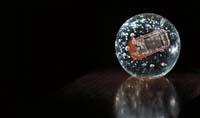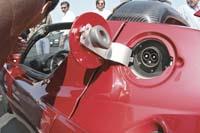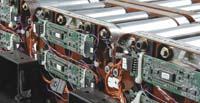How long?

"Electronics marketers reproach us for battery researchers who want to market new products and can't, because batteries don't allow it," says Miguel Bengoetxea, a researcher at CIDETEC-IK4, a battery expert. And when asked when the situation will change, he responds: "This is the question that all experts ask."
After more than fifteen years of history, there has been no revolution in batteries. If this is a lot or little time, it is a focus rating, but it is clear that for the electronics market in continuous renewal it is very long.
In the first lithium-ion batteries sold in 1991 the anode was made of coke, but for two years the graphite replaced the coke. However, since then there have been no revolutionary changes.
There have been some changes, improvements on the same model. Above all, they have optimized the interior space of the battery, introducing cathodes and anodes that require less space, thinner separation paper, etc. And they have also tested new materials for cathodes, which offer greater safety, but with lower energy density.
But experts expect great improvements. Bengoetxea believes that yes, that is, that the revolution will come. "Those of us who research batteries hope that in a couple of years there will be great changes; ultimately, we live and believe in it. But we believe the change will come from the automotive sector."

Electric cars
It can be a consequence of the economic crisis. It has had a great influence on the automotive sector and the General Motors crisis has been a clear example. And against this, governments have put in and put in money to reactivate the sector. And they have invested some of their money to give a boost to electric cars -- or hybrids. "They want to see the results," says Bengoetxea.
"Until a year ago there was talk about hydrogen cells in the world of new cars," says Oscar Miguel, head of the Energy Department at CIDETEC-IK4. "But today the situation has changed. In the field of batteries, the biggest breakthrough has occurred in the research of mobile phones." Development of lithium-ion batteries. At first they were expensive and had no great capacity. But mobile phones offered what they needed. A single lithium-ion battery replaced three nickel cadmium. They are now cheap and have come to the features demanded by a car: they provide an intensity of a few milliamps per hour and an energy of a few watts per kilo of battery. The type of battery is the same in mobile phones as in electric cars.
In fact, the research of electric cars has advanced a lot thanks to the study of lithium-ion batteries, more electric and hybrid. The latest models already have characteristics suitable for use in short trips. It has been studied very well the kilometers that a driver of the city travels daily and how the energy that is asked to the car changes. But still electric cars have limited autonomy and are not suitable for long trips.
Battery charging

Another challenge to overcome is that one of the biggest limitations of electric cars is the charging speed of batteries. The load is still slow. Manufacturers are making great efforts to get down to about three hours and in some cases they have. However, an hour later seems to be too slow, it should be noted that gasoline cars only take five minutes to fill the tank.
However, the solution is not batteries that charge very quickly. With small batteries, mobile phones, is not required. The load is carried out in an interval of approximately an hour and a half, not being priority for the market to reduce this time. One of the reasons is that they have designed a special charging system so that it does not load at the same speed at all times. At first hour approximately 90% of the mobile battery is charged at a very high intensity. From there the load is slower. In this way, it responds to an emergency, since although the charging time is low, the battery works correctly in a short time.
Of course, the battery of a phone is smaller than that of a car and its use is also different. And yet, the goal of engineers is not to achieve a technology that allows a quick load. "Experts are more concerned about the charging method than about technology," says Miguel. "If it could be charged in 5 minutes, it would be necessary to put a great power in that charge. Perhaps they would need 80 kilowatts per hour and there is no electrical grid to sustain it. The light force we use at home is 3 or 4 kilowatts per hour."
Therefore, experts seek to recharge electric cars at night or in low-power sections with the power provided by the domestic network. And without worrying about time. If most will use the electric car in the future it is very important. "If all users had the need to charge the car in a quarter of an hour and plugged in when they got home from work, they would burn the power grid," says Miguel. "There are studies that show that the current power grid has capacity for one million electric cars without modifications. The only condition would be to recharge in low consumption hours."
Next future

In recent years they have invested a lot in the research of electric and hybrid cars. But they still lack much to make them more abundant than gasoline cars, and that's not just going to happen with improving batteries. Market change.
But it is also necessary to improve the batteries. And experts are convinced that improving batteries for cars will inherit the world from small batteries. Thanks to this, the world of mobile phones and laptops can suffer the revolution that awaits. Research on electric cars will return what it owed by the development of lithium-ion batteries to research small batteries with a next technological revolution. Maybe.
Buletina
Bidali zure helbide elektronikoa eta jaso asteroko buletina zure sarrera-ontzian











